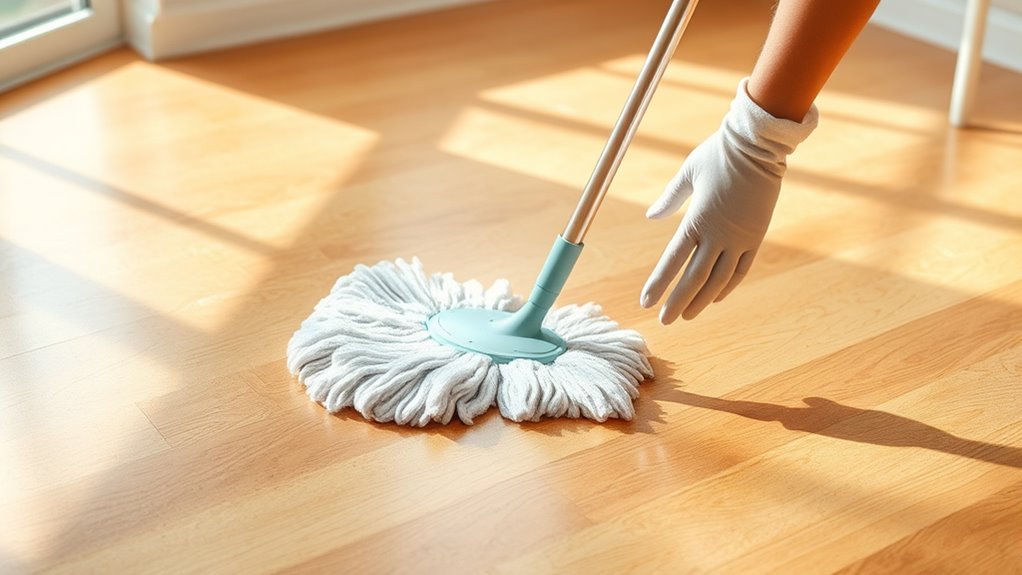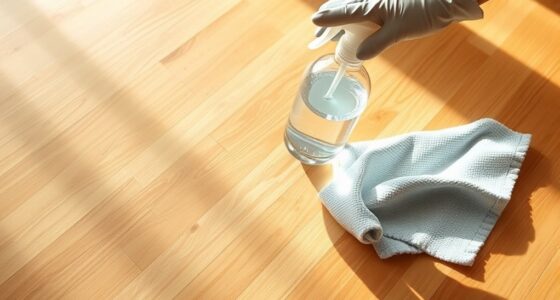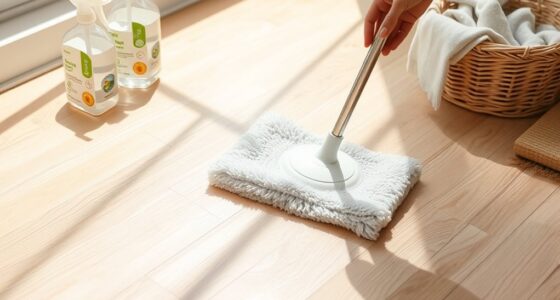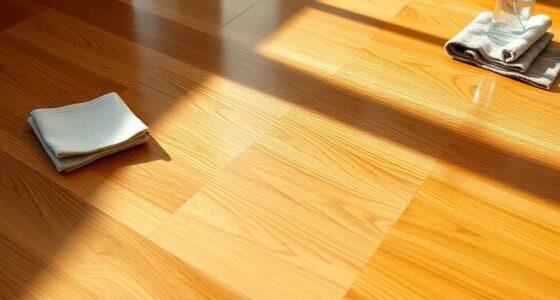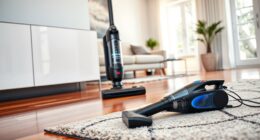To deep-clean cork floors without damage, start by removing loose debris with a soft broom or vacuum. Mix a mild cleaning solution with warm water and a few drops of gentle dish soap. Damp mop in small sections, following the grain to avoid scratches, and rinse the mop often. Immediately dry the surface with a soft cloth to prevent water damage. Keep your floors looking their best by following these careful steps—more tips await as you continue.
Key Takeaways
- Remove debris with a soft broom or vacuum before wet cleaning to prevent scratches.
- Use a damp microfiber mop with a mild cleaning solution, working in sections along the grain.
- Rinse the mop frequently and immediately dry the floor with a soft towel after mopping.
- Address stains promptly with gentle solutions like baking soda paste or vinegar, avoiding harsh scrubbing.
- Dry the floor thoroughly after cleaning and maintain regular gentle cleaning to preserve durability.
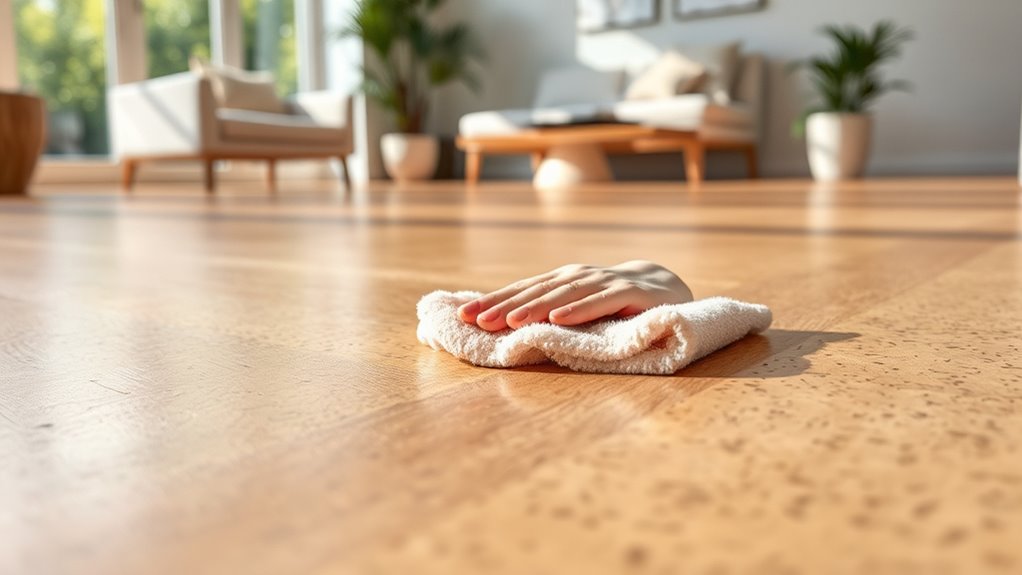
Cork floors are durable and eco-friendly, but they need regular deep cleaning to maintain their appearance and longevity. When it’s time for a thorough clean, you want to avoid damaging the surface while keeping it looking its best. Start by removing loose debris with a soft broom or vacuum designed for delicate floors. This initial step is vital to prevent scratches during wet cleaning. Once the surface is free of dirt, prepare a mild cleaning solution using a few drops of gentle dish soap mixed with warm water. Avoid harsh chemicals, as they can strip the cork’s protective finish and cause premature wear.
When it comes to mild cleaning, use a soft microfiber mop or cloth dampened—not soaked—in your cleaning solution. You want just enough moisture to lift dirt without saturating the cork, which can lead to swelling or warping. Wring out the mop thoroughly before applying it to the floor, and work in manageable sections to guarantee even cleaning. Always follow the grain of the cork to prevent streaks and scratches, and rinse the mop frequently to avoid spreading dirt around. After mopping, go over the floor with a clean, damp cloth to remove any residual soap or dirt. Dry the surface immediately with a soft towel or microfiber cloth to prevent water spots and damage. Additionally, proper maintenance practices can further extend the lifespan of your cork floors.
Stain removal on cork requires prompt action. When you notice a stain, avoid scrubbing harshly, which can damage the cork’s surface. Instead, create a paste with baking soda and water or use a mild vinegar solution, applying it gently to the stain with a soft cloth. Let it sit for a few minutes before blotting — never rubbing — to lift the stain without scratching the finish. For tougher stains, a commercial cork-safe cleaner can be effective, but always test it on a small, inconspicuous area first. Remember, patience is key; aggressive scrubbing or chemical use can permanently harm the cork.
Regular deep cleaning not only keeps your cork floors looking beautiful but also extends their lifespan. Incorporate routine stain removal and mild cleaning into your maintenance schedule, and you’ll preserve their natural charm for years to come. Avoid excessive moisture, harsh chemicals, and aggressive scrubbing, as these can all compromise the integrity of cork. With proper care, your floors will remain resilient, eco-friendly, and stunning for a long time.
Frequently Asked Questions
Can I Use Steam Cleaners on Cork Floors?
You should prevent using steam cleaning on cork floors because the high heat and moisture can damage the material. While DIY cleaning methods work well, steam cleaners can cause warping or swelling in cork surfaces. Instead, opt for gentle cleaning solutions and a damp mop to keep your cork floors looking their best without risking damage. Always follow manufacturer guidelines for cleaning to ensure longevity.
How Often Should I Deep-Clean Cork Floors?
You should deep-clean cork floors every 6 to 12 months, depending on foot traffic and wear. Regular maintenance tips include sweeping or vacuuming weekly to remove dirt and debris that can scratch the surface. Use gentle cleaning methods and avoid harsh chemicals. By maintaining a consistent cleaning frequency, you protect your cork flooring’s durability and appearance, ensuring it stays beautiful and damage-free for years to come.
Are There Specific Cleaning Products to Avoid?
Cleaning your cork floors is like tending a delicate garden—use the right tools. Avoid harsh chemicals and abrasive scrubbers, as they can damage the cork’s surface just as a rough hand on soft petals. Stick to pH-neutral cleaners and soft cloths or mops. These gentle products ensure your floors stay beautiful and intact, maintaining their resilience and appearance for years to come.
What’s the Best Way to Remove Stains From Cork?
To remove stains from cork floors, start by gently blotting the stain with a damp cloth and mild soap. For stubborn spots, use a mixture of baking soda and water, applying it softly to avoid damage. Always rinse and dry thoroughly afterward. This approach aids in stain removal and helps prevent discoloration, ensuring your cork floors stay vibrant and well-maintained over time.
Can I Refinish or Reseal Cork Floors After Deep Cleaning?
Imagine your cork floors shining anew, their surface smooth and vibrant. Yes, you can refinish or reseal after deep cleaning. The refinishing process involves lightly sanding to remove scratches, then applying a fresh coat of sealant. Resealing techniques vary but typically include cleaning thoroughly, repairing any damage, and sealing with a high-quality protective finish. This revitalizes your floors, extending their life and enhancing their natural beauty.
Conclusion
Now that you’ve learned how to deep-clean your cork floors without damage, you’ve revealed a secret garden of natural beauty beneath your feet. With gentle care, each cleaning session refreshes your space like a breath of spring air, revitalizing both your floors and your home’s spirit. Remember, your attention nurtures the cork’s resilience, turning maintenance into a dance of trust and tenderness. Keep this rhythm, and your floors will continue to tell their stories for years to come.
